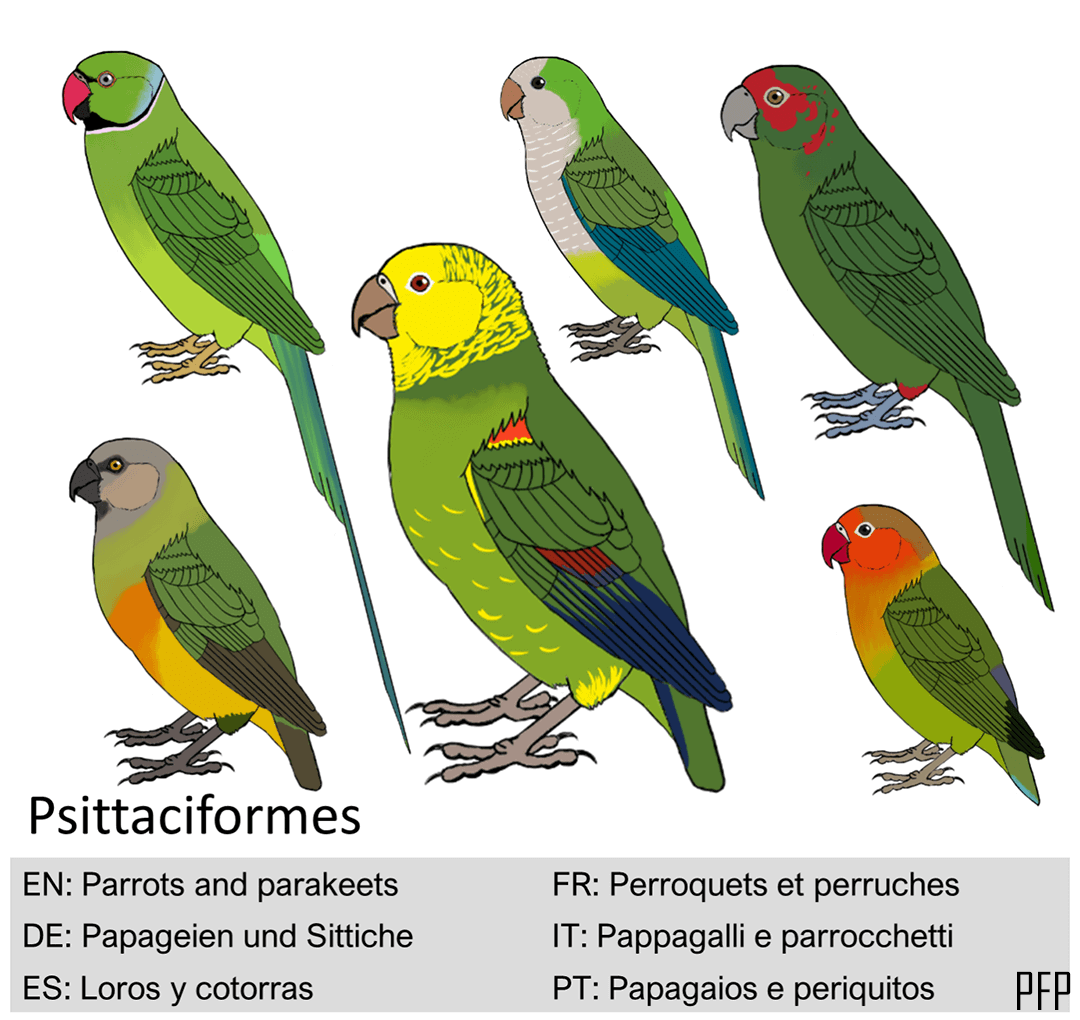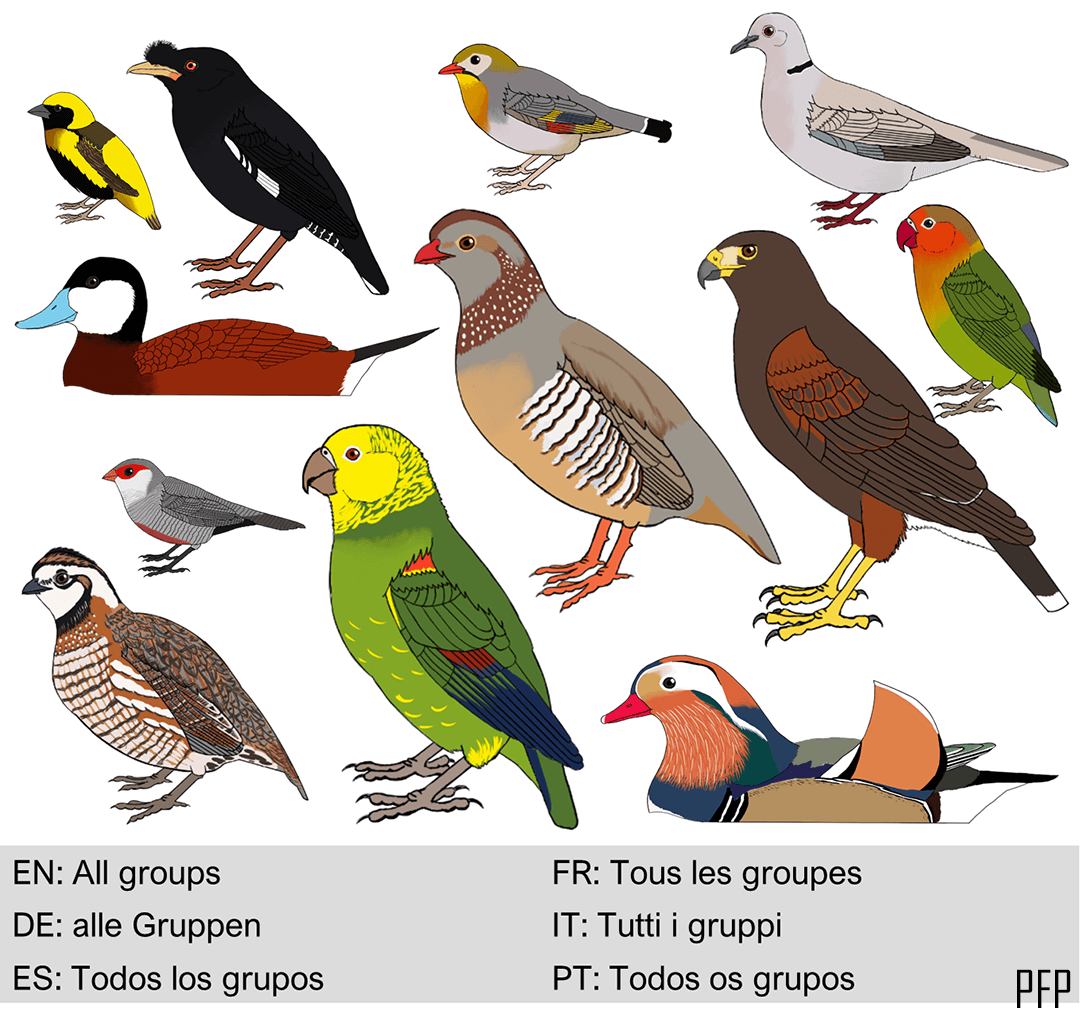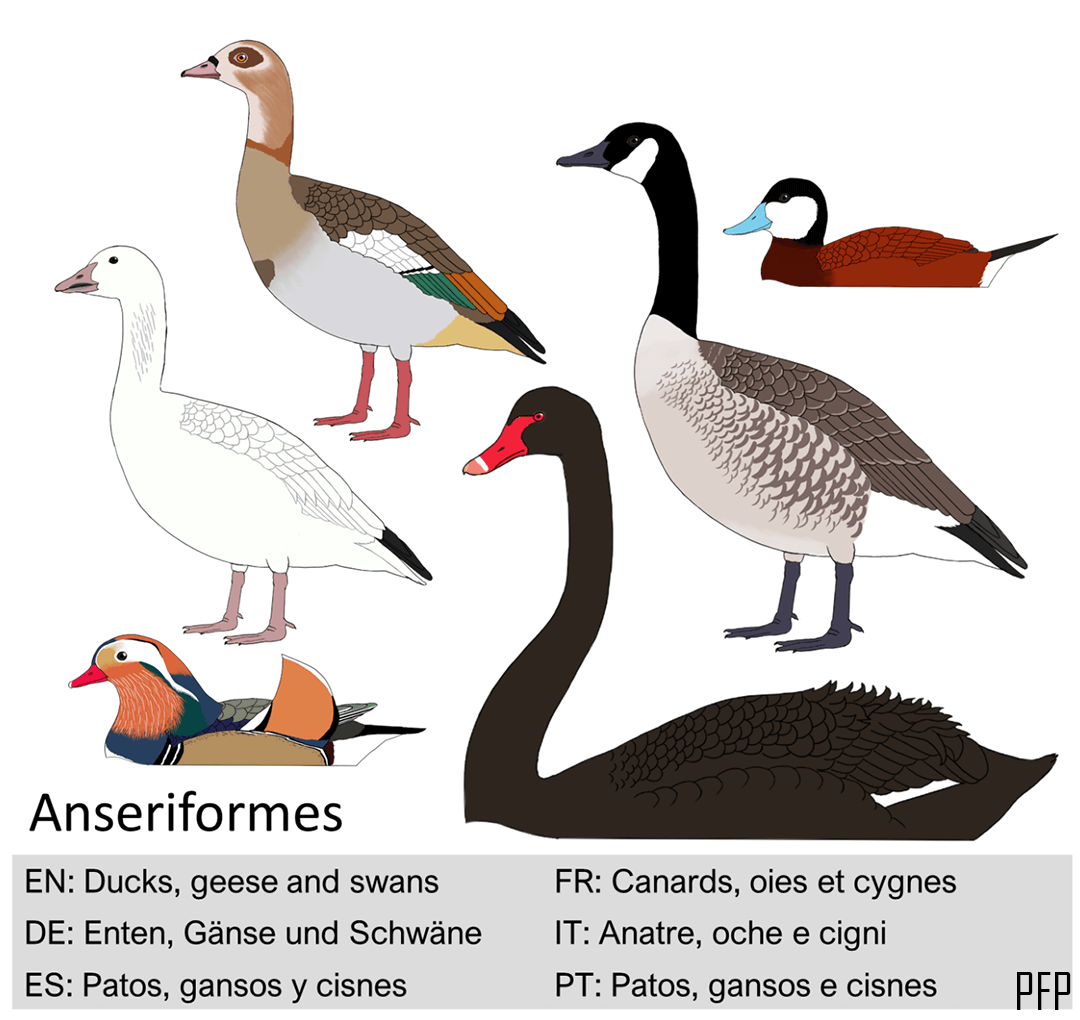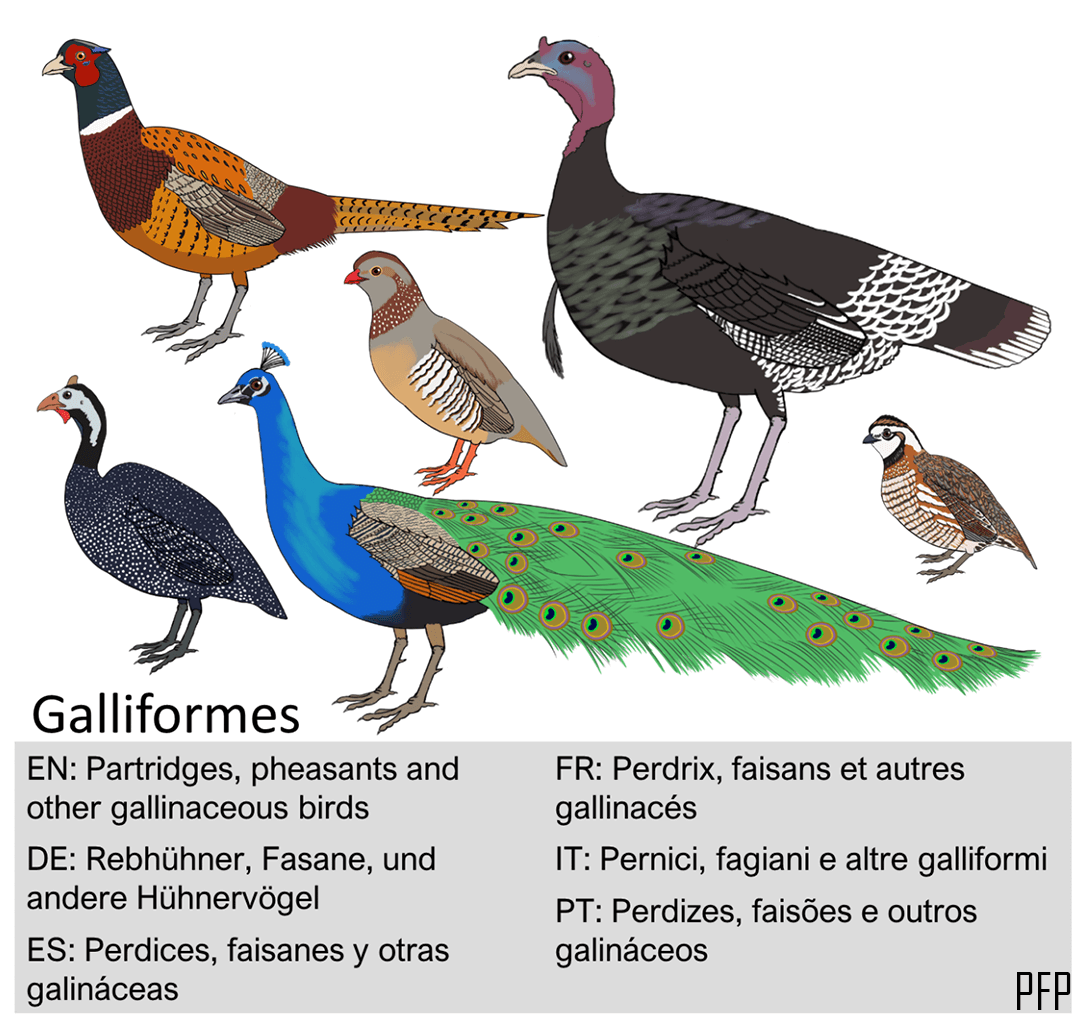RÉSULTATS D’IBISURVEY
dernière mise à jour: 05/12/2025
Nombre d'observations
Nombre de participants
Nombre d'espèces d'oiseaux exotiques
Top 10 des espèces signalées
- 542| Perruche à collier (Psittacula krameri) 22%
- 309| Ouette d’Égypte (Alopochen aegyptiaca) 12%
- 241| Ibis sacré (Threskiornis aethiopicus) 10%
- 193| Bernache du Canada (Branta canadensis) 8%
- 181| Léiothrix jaune (Leiothrix lutea) 7%
- 169| Perruche veuve (Myiopsitta monachus) 7%
- 101| Faisan de Colchide (Phasianus colchicus) 4%
- 95| Canard mandarin (Aix galericulata) 4%
- 90| Astrild ondulé (Estrilda astrild) 4%
- 56| Martin huppé (Acridotheres cristatellus) 2%
Interactions pour toutes les espèces exotiques
Nombre d’observations par pays
- 633| IT 25%
- 571| PT 23%
- 316| ES 13%
- 283| UK 11%
- 221| FR 9%
- 180| DE 7%
- 75| NL 3%
- 48| TR 2%
- 44| CH 2%
- 29| BE 1%
- 26| PL 1%
- 20| GR 1%
- 10 | RS 0%
- 10 | SE 0%
- 5 | HR 0%
- 4 | DK 0%
- 4 | AL 0%
- 4| LU 0%
- 4 | RO 0%
- 4 | SK 0%
- 3| AT 0%
- 3| CZ 0%
- 3| ME 0%
- 2| AZ 0%
- 2 | BG 0%
- 2 | NO 0%
- 1 | CY 0%
- 1 | FI 0%
- 1| HU 0%
- 1 | IE 0%
- 1 | RU 0%
- 1 | VA 0%
Avez-vous observé un oiseau introduit dans la nature?
Quel genre de comportements avez-vous observé?

Les oiseaux ont montré d’autres comportements

Enregistrez de votre observation!
Enregistrez de votre observation!
› avec photos: utilisateurs de Gmail | autres comptes
› sans photos
Merci de votre participation!
Le projet
Introduction
Depuis l’Antiquité, plusieurs espèces animales et de plantes ont été transportées hors de leur répartition naturelle pour la production de ressources (par exemple de la nourriture ou du bois), à des fins de chasse ou ornementaux. Une partie de ce transport entraîne des libérations intentionnelles ou accidentelles dans la nature. Le fait que l’espèce ne soit pas originaire d’un pays ou d’une région la rend exotique ou non indigène dans ce nouveau lieu. Une petite proportion des espèces exotiques introduites trouve des conditions appropriées pour s’installer et se reproduire dans le nouvel emplacement et démarrer un processus d’établissement sans soutien humain. Une proportion encore plus petite de ces espèces établies peut devenir envahissante si leur nombre augmente et se disperse au-delà du leur lieu d’introduction, ce qui pourrait avoir des conséquences négatives sur l’environnement, l’agriculture, la santé humaine ou l’économie.
Défis
L’impact des espèces introduites est difficile à évaluer lorsque les données sur leur répartition, leur abondance et leur comportement ne sont pas systématiquement obtenues.
Les espèces introduites peuvent ne pas être familières à la plupart des citoyens, car elles sont souvent absentes des guides ornithologiques populaires, limitées à une région particulière ou peuvent être confondues avec certaines espèces indigènes.
Objectifs
“Enquête sur les intéractions des oiseaux introduits” (Introduced Bird Interaction Survey – IBISurvey en anglais) est un projet de science citoyenne de l’Université d’Évora (Portugal) dont l’objectif principal est d’évaluer les impacts environnementaux, sociétaux et économiques des oiseaux introduits dans les pays européens. Communiquer sur le comportement des oiseaux introduits est la clé pour pouvoir déterminer leur impact, y compris s’ils s’alimentent de cultures agricoles et se comportent de manière agressive envers des individus d’espèces indigènes. Plus précisément, le projet vise (1) faciliter l’identification des oiseaux introduits auprès du grand public, (2) obtenir des informations sur la répartition, l’abondance et le comportement des espèces introduites, et (3) sensibiliser le public au sujet de l’impact des espèces introduites.
L’enquête
A travers l’enquête sur les interactions des oiseaux introduits, nous encourageons les citoyens à rapporter les interactions entre oiseaux introduits et autres animaux, plantes et humains. Les observateurs peuvent signaler toute espèce d’oiseau exotique introduite et détectée dans des conditions sauvages en Europe en introduisant le nom de l’espèce ou en sélectionnant une des espèces d’une liste que comporte les espèces plus fréquemment observées. A part cela, tout enregistrement d’espèces européennes introduites dans des pays où elles ne sont pas présentes naturellement sont également admis et bien accueillis. Une aide à l’identification des espèces introduites qui ne sont pas familières à l’observateur sera fournie grâce au téléchargement de photos.
Votre collaboration est essentielle pour permettre d’identifier quelles espèces d’oiseaux introduites deviennent envahissantes et pour améliorer l’évaluation de leurs impacts environnementaux, sociétaux et économiques. À titre d’exemple, les habitudes alimentaires d’un oiseau peuvent dévoiler un impact négatif sur les cultures agricoles ou un avantage concurrentiel sur une espèce indigène. Il est également important de rapporter le comportement reproductif des individus pour déterminer les possibilités de colonisation ou le succès de l’établissement d’une espèce. De plus, la description de la période de l’année, de l’habitat d’occurrence ou de la zone de reproduction augmentera les connaissances sur l’écologie des espèces dans la nouvelle région, s’avérant essentielle pour que la recherche progresse ou pour établir des plans d’éradication efficaces.
Espèces ciblées: Oiseaux introduits (ou leurs descendants) observés en liberté dans un lieu où ils sont arrivés par la main de l’homme.
Espèces non ciblées: oiseaux observés en captivité, comme ceux en cage de parcs zoologiques (oiseaux volants) ou en espaces clôturés (oiseaux incapables de voler).
IBISurvey est partenaire du Réseau européen d’information sur les espèces exotiques (EASIN).
Fiches d'espèces
Nous avons élaboré des fiches d’information sur des espèces d’oiseaux exotiques (1) introduites avec succès (espèces établies) en Europe ou (2) fréquemment observées à l’état sauvage mais sans populations établies connues. Ces fiches d’information résument (1) les conseils de d’identification basés sur le plumage des oiseaux, les comparant à des espèces similaires, (2) l’écologie de l’espèce, et (3) répertorie l’état actuel de l’établissement de l’espèce dans chaque pays et région.
En ce qui concerne le plumage, trois types peuvent être représentés: (1) le type sauvage: correspondant au plumage naturellement présent chez les individus dans leur pays d’origine; (2) le type domestique: résultant de la sélection par l’homme et de la reproduction domestique; (3) hybride: plumage résultant du croisement entre différentes espèces. Pour les types domestiques et les hybrides, seuls les exemples les plus courants sont représentés.
Le statut des espèces en Europe est une section constamment mise à jour en raison du continuel échappement des oiseaux, de leur introduction ou en raison du processus d’établissement prendre du temps. En outre, il y a peut-être des populations introduites qui n’ont toujours pas été découvertes.
Pour savoir comment identifier une espèce d’oiseau introduite en Europe, cliquez sur le lien:
Canards, oies et cygnes (Anseriformes)
Perdrix, faisans et autres gallinacés (Galliformes)
Perroquets et perruches (Psittaciformes)
Bibliographie et liens utiles
CAF (2020). Liste officielle des Oiseaux de France (catégories A, B et C). Ornithos 27-3, 170-185. Gill F, D Donsker & P Rasmussen (Eds). 2021. IOC World Bird List (v11.2). doi: 10.14344/IOC.ML.11.2.
Lepage, D., Vaidya, G., & Guralnick, R. (2014). Avibase – a database system for managing and organizing taxonomic concepts. ZooKeys, (420), 117.
Liens utiles pour obtenir images, vidéos et bruits d’oiseaux: www.ebird.org et www.xenocanto.org
Ali, S., & Ripley, S. D. (1999). Handbook of the Birds of India and Pakistan: Together with those of Bangladesh, Nepal, Sikkim, Bhutan and Sri Lanka. 10 Volume Set (Vol 1-10). Oxford University Press.
Andreotti, A., Besa, M., Genovesi, P., & Guberti, V. (2001). Mammiferi e Uccelli esotici in Italia: analisi del fenomeno, impatto sulla biodiversità e linee guida gestionali. N. Baccetti, & A. Perfetti (Eds.). Ministero dell’ambiente, Servizio conservazione natura.
Anton, M., Herrando, S., Garcia, D., Ferrer, X. & Cebrian, R. (2017). Atles dels ocells nidificants de Barcelona. Ajuntament de Barcelona/ICO/UB/Zoo. Barcelona
Arnold, R., Woodward, I. and Smith, N. (2018). Parrots in the London Area – A London Bird Atlas Supplement. London Natural History Society
Baccetti, N., Spagnesi, M., & Zenatello, M. (1997). Storia Recente Delle Specie Ornitiche Introdotte In Italia. Suppl. Ric. Biol. Selvaggina 27: 299-316.
Baicich, P. J., & Harrison, C. J. 0. (2005). A guide to the nests, eggs, and nestlings of North American birds. Second Ediction. Princeton University Press, Princeton and Oxford.
Baker, J., Harvey, K. J., & French, K. (2014). Threats from introduced birds to native birds. Emu-Austral Ornithology, 114(1), 1-12.
Banks, A. N., Wright, L., Maclean, I. M., Hann, C., & Rehfisch, M. M. (2008). Review of the status of introduced non-native waterbird species in the area of the African-Eurasian Waterbird Agreement: 2007 update. Norfolk, United Kingdom: British Trust for Ornithology.
Bauer, H. G., & Woog, F. (2008). Nichtheimische Vogelarten (Neozoen) in Deutschland, Teil I: Auftreten, Bestände und Status. Vogelwarte, 46(3), 157-194.
Bauer, H. G., Geiter, O., Homma, S., & Woog, F. (2016). Vogelneozoen in Deutschland–Revision der nationalen Statuseinstufungen. Vogelwarte, 54, 165-179.
Blackburn, T. M., & Duncan, R. P. (2001). Determinants of establishment success in introduced birds. Nature, 414(6860), 195-197.
Blackburn, T. M., Lockwood, J. L., & Cassey, P. (2009). Avian invasions: the ecology and evolution of exotic birds (Vol. 1). Oxford University Press.
Blackburn, T. M., Pyšek, P., Bacher, S., Carlton, J. T., Duncan, R. P., Jarošík, V., … & Richardson, D. M. (2011). A proposed unified framework for biological invasions. Trends in ecology & evolution, 26(7), 333-339.
Bon, M., Semenzato, M., Fracasso, G., & Marconato, E. (2008). Sintesi delle conoscenze sui Vertebrati alloctoni del Veneto. Boll. Mus. civ. St. nat. Venezia, 58, 37-64.
Borrow, N., & Demey, R. (2014). Birds of Western Africa. Helm Field Guides, London.
Carrete, M., & Tella, J. (2008). Wild‐bird trade and exotic invasions: a new link of conservation concern?. Frontiers in Ecology and the Environment, 6(4), 207-211.
Cassey, P., Blackburn, T. M., Sol, D., Duncan, R. P., & Lockwood, J. L. (2004). Global patterns of introduction effort and establishment success in birds. Proceedings of the Royal Society of London. Series B: Biological Sciences, 271(suppl_6), S405-S408.
Cheke, A. (2019). A long-standing feral Indian Peafowl population in Oxfordshire, and a brief survey of the species in Britain. British Birds, 112, 337-348.
Chiron, F., Shirley, S., & Kark, S. (2009). Human-related processes drive the richness of exotic birds in Europe. Proceedings of the Royal Society B: Biological Sciences, 276(1654), 47-53.
Clement, P. (1999). Finches and sparrows. Bloomsbury Publishing.
Cramp, S. & Perrins, C. M. (1994). The birds of the Western Palearctic. Oxford University Press, Oxford
Cucco, M., Alessandria, G., Bissacco, M., Carpegna, F., Fasola, M., Gagliardi, A., … & Pellegrino, I. (2021). The spreading of the invasive sacred ibis in Italy. Scientific Reports, 11(1), 1-13.
De Juana, E., & Garcia, E. (2015). The birds of the Iberian Peninsula. Bloomsbury Publishing.
Del Hoyo, J., Elliott, A., Sargatal, J., Christie, D. A., & de Juana, E. E. (2018). Handbook of the birds of the world alive. Barcelona: Lynx Edicions.
Dubois, P. J. (2007). Les oiseaux allochtones en France: statut et interactions avec les espèces indigènes. Ornithos, 14, 329–364.
Dubois, P. J., Maillard, J. F., & Cugnasse, J. M. (2016). Les populations d’oiseaux allochtones en France en 2015 (4 e enquête nationale). Ornithos, 23, 129-141.
Duncan, R. P., Blackburn, T. M., & Sol, D. (2003). The ecology of bird introductions. Annual Review of Ecology, Evolution, and Systematics, 34(1), 71-98.
Dunn, J. L. & Alderfer, J. (2017). Field guide to the birds of North America. National Geographic Books.
Essl, F. & Rabitsch, W. (2002): Neobiota in Österreich. Umweltbundesamt, Wien, 432 pp.
Fox, A. D., Heldbjerg, H., & Nyegaard, T. (2017). Invasive alien birds in Denmark. Citizen Science Based Bird Population Studies, 187.
Frith, C. B. (2004). The Birds of Africa. Volume VII (Eds C. Hilary Fry and Stuart Keith). Christopher Helm, London.
Gibbs, D., Barnes, E., & Cox, J. (2010). Pigeons and doves: a guide to the Pigeons and doves of the world. London, UK: A&C Black Publishers
Global Biodiversity Information Facility: www.gbif.org
Hagemeijer, W. J., & Blair, M. J. (1997). The EBCC atlas of European breeding birds. Poyser, London, 479.
Harrison, C. J. O. & Castel, P. (2002). Field guide to the nests, eggs and nestlings of Britain and Europe. Collins.
Holling, M., & the Rare Breeding Birds Panel. (2017). Non-native breeding birds in the UK, 2012–14. Brit. Birds 110: 92–108
Hulme, P. E., Bacher, S., Kenis, M., Klotz, S., Kühn, I., Minchin, D., … & Vilà, M. (2008). Grasping at the routes of biological invasions: a framework for integrating pathways into policy. Journal of Applied Ecology, 45(2), 403-414.
iNaturalist: www.inaturalist.org
Institute of Nature Conservation PAS: www.iop.krakow.pl
Invasive Species in Belgium: http://ias.biodiversity.be/
Johnsgard, P. A. (1978). Ducks, geese, and swans of the world. – University of Nebraska Press, 1st edition, Lincoln, Nebraska
Keller, V., Herrando, S., Voříšek, P., Franch, M., Kipson, M., Milanesi, P., Martí, D., Anton, M., Klvaňová, A., Kalyakin, M.V., Bauer, H.-G. & Foppen, R.P.B. (2020): European Breeding Bird Atlas 2: Distribution, Abundance and Change. European Bird Census Council & Lynx Edictions. Barcelona
Kestenholz, M., Heer, L., & Keller, V. (2005). Etablierte Neozoen in der europäischen Vogelwelt–eine Übersicht. Ornithol. Beob, 102(3), 153-180.
Kumschick, S., & Nentwig, W. (2010). Some alien birds have as severe an impact as the most effectual alien mammals in Europe. Biological conservation, 143(11), 2757-2762.
Lensink, R., Ottens, G., & van der Have, T. (2013). Vreemde vogels in de Nederlandse vogelbevolking: een verhaal van vestiging en uitbreiding. Limosa, 86(2), 49-67.
Lever, C. (2005). Naturalised birds of the world. A&C Black.
Lukasiewicz, M., Matuszewski, A., Kamaszewski, M., & Wardecki, L. (2018). Selected invasive species of the Polish and European avifaunae. Annals of Warsaw University of Life Sciences-SGGW. Animal Science, 57.
Madge, S., McGowan, P. J., & Kirwan, G. M. (2002). Pheasants, partridges and grouse: a guide to the pheasants, partridges, quails, grouse, guineafowl, buttonquails and sandgrouse of the world. A&C Black
Matias, R. (2002). Aves exóticas que nidificam em Portugal continental. Instituto da Conservação da Natureza. Lisboa
Menkhorst, P., Rogers, D., Clarke, R., Davies, J., Marsack, P., & Franklin, K. (2017). The Australian bird guide. Csiro Publishing.
Mentil L., Battisti C. & Carpaneto G.M. (2018). The impact of Psittacula krameri (Scopoli, 1769) on orchards: first quantitative evidence for Southern Europe. Belgian Journal of Zoology 148 (2): 129–134.
Mlíkovský, J. & Stýblo P. (Eds.) (2006): Nepůvodní druhy fauny a flóry České republiky. Praha: ČSOP.
Mori, E., Grandi, G., Menchetti, M.,Tella, J. L., Jackson, H. A., Reino, L., van Kleunen, A., Figueira, R. & Ancillotto, L. (2017). Worldwide distribution of non–native Amazon parrots and temporal trends of their global trade. Animal Biodiversity and Conservation, 40.1: 49–62.
National Biodiversity Network Atlas: https://records.nbnatlas.org
Naturbasen – Danmarks National Artsportal: https://www.naturbasen.dk/
Nehring, S., Rabitsch, W., Kowarik, I., & Essl, F. (Eds.). (2015). Naturschutzfachliche Invasivitätsbewertungen für in Deutschland wild lebende gebietsfremde Wirbeltiere. Bundesamt für Naturschutz.
Nikolov, B., Kralj, J., Legakis, A., Saveljic, D. & Velevski, M. (2016). Review of the alien bird species recorded on the Balkan Peninsula. In: Rat M., T. Trichkova, R. Scalera, R. Tomov, A. Uludag (Eds.), First ESENIAS Report: State of the Art of Invasive Alien Species in South-Eastern Europe. Publishers: UNS PMF, Novi Sad, Serbia, IBER-BAS, Sofia, Bulgaria, ESENIAS, ISBN:978-86-7031-3316, 189-201
Norwegian Biodiversity Information Centre (2018). The Alien Species List of Norway – ecological risk assessment 2018. https://www.biodiversity.no/alien-species-2018
Nowakowski, J. J., & Dulisz, B. (2019). The Red-vented Bulbul Pycnonotus cafer (Linnaeus, 1766)–a new invasive bird species breeding in Europe. BioInvasions Records, 8(4), 947-952.
Ornitho France: www.Ornitho.fr
Ornitho Italia: www.ornitho.it
Ottens, G., & Ryall, C. (2003). House crows in the Netherlands and Europe. Dutch Birding, 25, 312-319.
Pagani–Núñez, E., Renom, M., Furquet, C., Rodríguez, J., Llimona, F., & Senar, J. C. (2018). Isotopic niche overlap between the invasive leiothrix and potential native competitors. Animal Biodiversity and Conservation, 41(2), 427-434.
Parr, M., & Juniper, T. (2010). Parrots: a guide to parrots of the world. Bloomsbury Publishing.
Pereira, P. F., Barbosa, A. M., Godinho, C., Salgueiro, P. A., Silva, R. R., & Lourenço, R. (2020). The spread of the red-billed leiothrix (Leiothrix lutea) in Europe: The conquest by an overlooked invader?. Biological Invasions, 22(2), 709-722.
Pereira, P. F., Godinho, C., Vila-Viçosa, M. J., Mota, P. G., & Lourenço, R. (2017). Competitive advantages of the red-billed leiothrix (Leiothrix lutea) invading a passerine community in Europe. Biological Invasions, 19(5), 1421-1430.
Pereira, P. F., Lourenço, R., & Mota, P. G. (2018). Behavioural dominance of the invasive red-billed leiothrix (Leiothrix lutea) over European native passerine-birds in a feeding context. Behaviour, 155(1), 55-67.
Pereira, P. F., Lourenço, R., & Mota, P. G. (2020). Two songbird species show subordinate responses to simulated territorial intrusions of an exotic competitor. acta ethologica, 23(3), 143-154.
Poole, K. (2010). Bird introductions. Extinctions and Invasions: a social history of British fauna, 155-165.
Ramellini, S., Simoncini, A., Ficetola, G. F., & Falaschi, M. (2019). Modelling the potential spread of the Red-billed Leiothrix Leiothrix lutea in Italy. Bird Study, 66(4), 550-560.
Rasmussen, P. C., & Anderton, J. C. (2012). Birds of south Asia. The Ripley Guide. Vols. 1 and 2. Second Edition. National Museum of Natural History – Smithsonian institution, Michigan State University and Lynx Edictions, Washington, D.C., Michigan and Barcelona.
Robson, C. (2008). A field guide to the birds of South-east Asia. London, UK: New Holland Publishers Ltd.
Sanz-Aguilar, A., Anadón, J.D., Edelaar, P., Carrete, M. & Tella, J.L. (2014). Can Establishment Success Be Determined through Demographic Parameters? A Case Study on Five Introduced Bird Species. PLoS ONE 9(10): e110019. doi:10.1371/journal.pone.0110019
Senar, J. C., Carrillo-Ortiz, J. G., Ortega-Segalerva, A., Dawson Pell, F. S. E., Pascual, J., Arroyo, L., … & Hatchwell, B. J. (2019). The reproductive capacity of Monk Parakeets Myiopsitta monachus is higher in their invasive range. Bird Study, 66(1), 136-140.
Sibley, D.A. (2014). The North American Bird Guide. 2nd Edition. Bloomsbury, New York.
Sol, D., Bartomeus, I., & Griffin, A. S. (2012). The paradox of invasion in birds: competitive superiority or ecological opportunism?. Oecologia, 169(2), 553-564.
Sol, D., Timmermans, S., & Lefebvre, L. (2002). Behavioural flexibility and invasion success in birds. Animal behaviour, 63(3), 495-502.
Species Obseration System – SLU Artdatabanken: https://www.artportalen.se/
Šťastný, K. (2018). Nepůvodní ptáci ve fauně České republiky. Živa 5/2018: 272-276.
Svensson, L., Mullarney, K., & Zetterström, D. (2010). Collins bird guide 2nd edition. British Birds, 103, 248-252.
UNEP-WCMC. 2015. Update on the status of non-native waterbird species within the AEWA Area. Cambridge: UNEP-WCMC
Vall-llosera, M., Llimona, F., de Cáceres, M., Sales, S., & Sol, D. (2016). Competition, niche opportunities and the successful invasion of natural habitats. Biological invasions, 18(12), 3535-3546.
Vavřík M., Šírek J., Šindel M., Mlíkovský J., Horáček J., Heyrovský D. & Šimek J. 2019: Revize záznamů vzácných druhů ptáků v České republice. Sylvia 55: 2–74.
Waarneming: https://waarneming.nl
Waarnemingen: https://waarnemingen.be
White, R. L., Strubbe, D., Dallimer, M., Davies, Z. G., Davis, A. J., Edelaar, P., … & Shwartz, A. (2019). Assessing the ecological and societal impacts of alien parrots in Europe using a transparent and inclusive evidence-mapping scheme. NeoBiota, 48, 45.
Yésou, P. & Clergeau, P. (2005). Sacred Ibis: a new invasive species in Europe. Birding World 18 (12): 517-526.
Collaborateurs et financement
Équipe de Recherche (University of Évora, Portugal):
Pedro Filipe Pereira
Carlos Godinho
Inês Roque
João Eduardo Rabaça
Rui Lourenço
Collaborateurs:
Ana Diniz Sampaio, University of Évora
David Epple, Technical University of Munich
Elsa Leclerc Duarte, University of Évora
Fer Goytre, Fotografía de Naturaleza
Francesco Valerio, University of Évora
Hany Alonso, Portuguese Society for the Study of Birds (SPEA)
Pedro Alexandre Salgueiro, University of Évora
Pedro Almeida, University of Évora
Teresa Gomes, University of Évora
Illustrations:
Pedro Filipe Pereira
Photographies:
Alessandro Mariani, Italia; Leiothrix lutea et Parus major
Carlos Santos, Alapraia, Portugal; Acridotheres cristatellus chanteur
Carlos Sarabia, Fotografía de Naturaleza, España; Pycnonotus jocosus
Carole Philippon, France, Instagram: @carole.nature.photos; Enquête: Leiothrix lutea et Erithacus rubecula
Christian Almendro, España, Instagram: @kostripadventure; Pavo cristatus cour nuptiale
Elena Giuffra, Italia, Instagram: @elena.giuffra; 2 Leiothrix lutea alimentation
Eva M Sánchez-Flores, España, Instagram: @evalynxphotograph; Estrilda astrild alimentation
Fátima Mendes, Portugal; Acridotheres cristatellus et cheval
Francisco Santos, Portugal; Estrilda astrild alimentation des jeunes
Hawi Grömping, Germany, www.naturschule.com; Enquête: Phoenicopterus chilensis et Phoenicopterus roseus
Jean Yves Paquereau, photographie de la nature, France; Threskiornis aethiopicus
João Lelo, Portugal, Instagram: @joaolelophotography; Ploceus melanocephalus
Mala Patel, Director The Caketail Club, England, the United Kingdom; 2 Psittacula krameri
Mar López, Fotografía de Naturaleza, Alcalá de Henares, España; Myiopsitta monachus alimentation
Mari Carmen López Luengo, España, Instagram: @mcarmen_photography; Myiopsitta monachus et Columba livia
Paul Abrahams, the United Kingdom, www.gingerwildlifephotography.co.uk; Branta canadensis et Anser anser; Branta canadensis et Cygnus olor
Pedro Filipe Pereira, University of Évora, Portugal; Pavo cristatus couvant
Peter Koenis, the Netherlands; Cygnus atratus et Cygnus olor
Philip John Passey, England, the United Kingdom; Psittacula krameri et Corvus monedula
Samuele Ramellini, University of Milan, Italy; Leiothrix lutea couple; 1 Leiothrix lutea alimentation
Saskia Lemmens, Sayly Photography, the Netherlands; Alopochen aegyptiaca et Ciconia ciconia
Teresa Palacios, Fotógrafa, España, www.teresapalacios.es; Phasianus colchicus cour nuptiale
Ton Petrus, the Netherlands; Psittacula krameri alimentation
Vie Schoen, the Netherlands; Phoenicopterus chilensis copulation
William Atkinson, Mid-Wales, the United Kingdom; Phasianus colchicus combat
Financement:
MED (IUPB/05183/2020) – Fundação para a Ciência e Tecnologia
Contacts:
LabOr – Laboratory of Ornithology
MED – Mediterranean Institute for Agriculture, Environment and Development
Instituto de Investigação e Formação Avançada
Universidade de Évora, Pólo da Mitra, Ap. 94, 7006-554 Évora, Portugal
Téléphone: 00351 266 760 897
E-mail: labor@uevora.pt
Research Team (University of Évora, Portugal)

Carlos Godinho
Inês Roque
João Eduardo Rabaça
Pedro Filipe Pereira
Rui Lourenço
Les oiseaux ont montré un comportement de reproduction
Ouette d’Égypte (Alopochen aegyptiaca) – compétition pour les sites de nidification / comportement agressif: de l’espèce introduite envers un autre animal (Cigogne blanche – Ciconia ciconia)
Faisan de Colchide (Phasianus colchicus) – comportement territorial (combat) / comportement agressif: entre individus de l’espèce introduite
Perruche à collier (Psittacula krameri) – compétition pour les sites de nidification / comportement agressif: de l’espèce introduite envers un autre animal (Choucas des tours – Corvus monedula)
Les oiseaux ont montré d’autres comportements
Léiothrix jaune (Leiothrix lutea) – alimentation: cultures (kaki)
Astrild ondulé (Estrilda astrild) – alimentation: plantes sauvages (graines de jonc)
Perruche à collier (Psittacula krameri) – alimentation: nourriture dans un mangeoire à oiseaux / comportement agressif: entre individus de l’espèce introduite
Léiothrix jaune (Leiothrix lutea) – alimentation: cultures (kaki) / comportement agressif: de l’espèce introduite envers un autre animal (Mésange charbonnière – Parus major)
Perruche à collier (Psittacula krameri) – alimentation: plantes ornementales (fleurs de cerisier)
Bernache du Canada (Branta canadensis) – nage / comportement agressif: de l’espèce introduite envers un autre animal (Oie cendrée – Anser anser)
Bernache du Canada (Branta canadensis) – nage / comportement agressif: d’un animal (Cygne tuberculé – Cygnus olor) envers l’espèce introduite
Cygne noir (Cygnus atratus) – nage / comportement agressif: de l’espèce introduite envers un autre animal (Cygne tuberculé – Cygnus olor)
Perruche veuve (Myiopsitta monachus) – comportement social: l’ espèce introduite était associée à d’autres animaux (Pigeon domestique – Columba livia) sans montrer de comportement agressif
Martin huppé (Acridotheres cristatellus) – comportement social: l’ espèce introduite était associée à d’autres animaux (cheval) sans montrer de comportement agressif




































